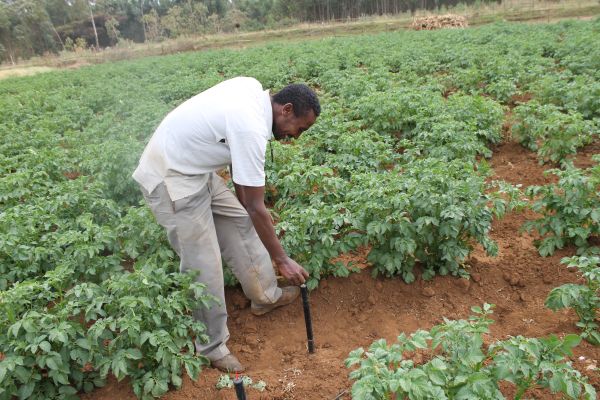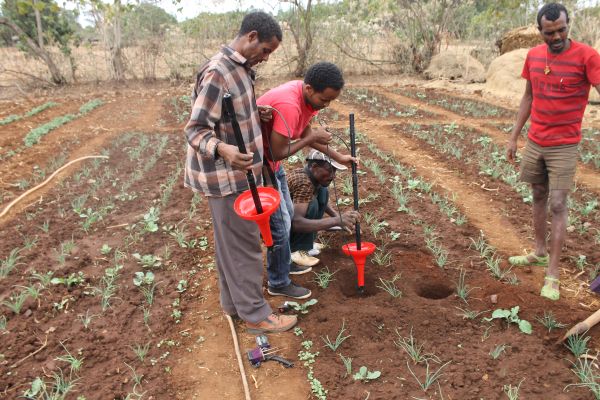A new irrigation technology is helping Ethiopian farmers assess crop water requirements
In water-scarce areas, managing water more wisely could also bring huge benefits: by keeping irrigation to an optimum level, water supplies can be made to last longer during dry periods and costs for labor and pumping are kept at a minimum

To explore how to help farmers manage watering better, IWMI has introduced a simple irrigation scheduling technology at six sites in various parts of Ethiopia in January this year. These wetting front detectors (WFDs) are basically tubes buried in the soil containing a calibrated float. When the soil water gets a certain level, the float rises, indicating that the desired level of wetness has been attained. Detectors were distributed to sixteen female and sixty seven male farmers to improve irrigation of wheat, vegetables, fodder and fruit trees. Typically local farmers have followed blanket recommendations for irrigating their cropland without considering the soil type, climatic conditions, or growth stage and type of crops.
Comparing traditional irrigation practices with the fields where the WFDs were used showed that farmers tended to both under and over irrigate under the old system. Both are problematic. The former leads to low productivity of crops. The latter raises the groundwater table and can encourage soil salinity, degrading the land. Overall farmers were putting in more effort than was needed and provoking unnecessary conflicts over access to irrigation water.
But the detectors made a huge difference. At one site in Koga, near Lake Tana, water consumption for wheat and potato was reduced on average by 36% when irrigation was performed using the WFD.
Farmers get the wet
Recent field visits have confirmed that the WFDs are making farmers think twice about how they irrigate. At the two Lake Tana sites, farmers were given a training session led by IWMI’s Petra Schmitter and Melaku Tessema of Bahir Dar University (one of the project partners), and encouraged to contribute feedback.
“We are very happy with the WFD installed by IWMI,” said Belay Zeleke, the Koga Irrigation Project manager. “There is no shortage of water in Koga, rather lack of clear indicators and standards that can identify when and how much water is needed for particular crops. We usually irrigate wheat every eight to ten days, but after the introduction of the WFD the irrigation scheduling was pushed to 14 or even 21 days.”
Liyu Fetene, one of the farmers involved in the pilot, agreed. “The device helped us save time and labor by reducing irrigation frequency without affecting the growth and performance of the crops,” he said.

During the field visit, the farmers and experts assessed crop performance and yield under the test conditions and compared this to a control plot where regular 8-10 day watering was continued. Overall there was no marked difference in crop performance, clearly showing that applying less water was a viable strategy, saving both time and labor.
Future plans include partnering with irrigation water users associations to investigate how the use of WFD can improve overall irrigation scheme management and potentially reduce water conflicts. Researchers are also keen to find out what factors might encourage more farmers to adopt WFDs and what the economic benefits might be.
This work is part of the following initiatives:
CGIAR Research Program on Water Land and Ecosystems
Livestock and Irrigation Value Chains for Ethiopian Smallholders (LIVES)
Innovation Lab for Small Scale Irrigation (ILSSI)
The wetting front detectors were developed by Richard Stirzaker of Australia’s CSIRO under the Water Research Commission Research Project No 188 in South Africa and are produced by Agriplas

